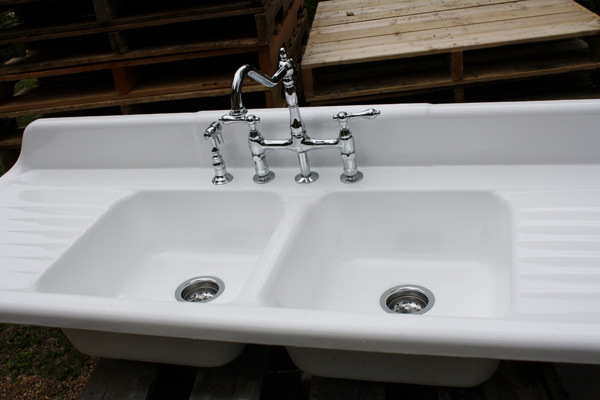Blog Highlights:
- Although the sink is constantly exposed to soaps and to cleaning solutions, it does not mean that the sink will constantly look clean
- You need to clean the sink carefully so you can avoid damaging it and so you can avoid corrosion
- Cast iron sinks are tough and durable but they are susceptible to scratching
- Never use rough cleaning tools like steel wool or wire brushes so you can avoid rusting your sink
- Granite sinks can form a white haze when it has mineral deposits from hard water
- You can use baking soda to remove stuck-on food and debris, and you can use vinegar to disinfect the sinks and to remove hard water stains
Different types of kitchen sinks require different techniques for effective cleaning.
Some say that the sink works the hardest in the kitchen. While you use it to clean dishes and utensils, you need to consider whether or not the sink itself needs cleaning.
The sink is constantly exposed to soap, hot water, and to different chemicals from various cleaning solutions, but that does not mean that the sink will virtually clean itself. As a matter of fact, the all the soap and the cleaning agents might be the reason why you are about to face a very difficult problem.
To help you deal with the kitchen sink, here is a guide that you can closely follow so you can clean it no matter what type of material your sink is made of. You can prepare the materials needed beforehand, but you need to make sure that you stay away from steel wool, wire brushes, and scrubbing pads so you can avoid damaging your sink. Although they may be good for cleaning tough pots and pans, you need to gently clean your sink so you can avoid corrosion.
Cleaning Cast Iron sinks

Cast iron sinks are made from heavy duty iron alloy, but it has a porcelain enamel layer which has been fired on top.
Used typically in vintage houses or farmhouse kitchens, these sinks have a long-lasting glossy finish that you need to take good care of. As tough as these sinks may look, they are still very susceptible to scratching and wear especially if they are not maintained properly.
Step 1: Use a mild dishwashing liquid that can remove grease. Dilute it in a gallon of warm water and apply it on the sink using a soft cloth or sponge.
Step 2: Rinse the sink with hot water and let it dry afterwards with a clean cloth.
Step 3: If there are stains around the drain, plug the drain and fill the sink with hot water. Add two cups of vinegar and let this mixture stay for four hours. The vinegar will help remove hard water stains. Rinse it afterwards with hot water, and dry it with a cloth.
Step 4: If you have to deal with very tough stains, you need to mix a quarter cup of ammonia with a quarter cup of baking soda in a gallon of warm water. Dab this solution into the sink using a soft cloth or sponge, and scrub the stained areas thoroughly. Rinse the area afterwards with hot water and dry it after with a clean cloth.
Step 5: If you want to make the sink shine, you can wipe it with a few tablespoons of olive oil after cleaning.
Cleaning Stainless Steel sinks

Used mainly in industrial kitchen designs, it can also be adapted to any kitchen type. It is known to be very durable and it is also non-porous, making it very easy to clean and disinfect. Although this type of sink seems to be indestructible, cleaning it should be done gently so you can avoid scratching its surfaces since this will allow the rust to corrode the sink.
Step 1: Rinse the sink first with hot water to loosen or remove any debris or stuck-on food. You should also rinse the stoppers and the drain strainers as well.
Step 2: Plug the drain and pour baking soda in the sink basin, the rim, and the faucet. This will help you remove stuck-on food, debris, and grease later on. The baking soda is tough on stains but is gentle enough to avoid scratching the sink.
Step 3: Spray the area with white distilled vinegar. Let the mixture fizz. This will help remove microbes and it will also help you get rid of hard water stains.
Step 4: You can scrub the solution using a soft-bristle toothbrush in a circular motion. You can also do this to clean the corners of the faucet and the sink basin near the countertop.
Step 5: Rinse the sink with hot water and dry it with a water cloth afterwards to prevent the formation of water stains.
Step 6: To shine stainless steel sinks, you can sprinkle it with flour and rub it afterwards with a soft cloth. You can also rub it with olive oil.
Cleaning Porcelain or Fireclay sinks

Porcelain sinks are made by molding clay into a desired shape and by fusing it with porcelain enamel. These sinks often incorporate timeless designs and they usually come in a wide variety of colors that will allow you to use it in any kitchen style.
Step 1: To clean its surfaces, you need to use hot water, a soft cloth or sponge, as well as a dish soap that can remove grease. You need to apply the soap in a circular motion to remove food and other debris.
Step 2: Rinse the soap with hot water, and dry it afterwards with a soft cloth.
Step 3: You can sprinkle the sink with baking soda if it has tough stains. Rub the stain in a circular motion with a soft cloth. Rinse it with hot water and dry properly afterwards.
Step 4: To remove gunk and grime around the sink, you can plug the drain and fill it with hot water. Pour two cups of vinegar and let the solution stay for four hours. Rinse it afterwards and dry thoroughly.
Cleaning Granite sinks

Granite sinks are very popular in modern kitchen designs simply because it has a sleek and seamless look. Granite sinks are very durable and they are known to be able to withstand scrubbing. This type of sink however, is very susceptible to mineral deposits especially from hard water. It can easily develop a white haze on its surfaces. This is why you should never use products that contain citrus or bleach when cleaning granite.
Step 1: You can use a few drops of dish soap in a gallon of warm water for routine cleaning. Rub this solution on the granite sink’s basin, on the sides, and also on the rim. Rinse the sink with hot water.
Step 2: If you want to get rid of tough stains, you can mix hydrogen peroxide with whiting powder. Be sure to follow the instructions of the whiting powder product carefully. You can apply this mixture on the stain area directly. Let it sit for a few hours and wipe away the dried paste with a sponge. Rinse the area with hot water.
Step 3: If you want to remove the white haze, you can rub the area with a few teaspoons of olive oil and a soft cloth. Rub it into the sink thoroughly and buff any excess






